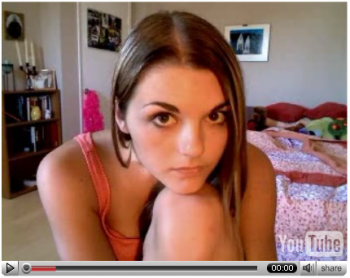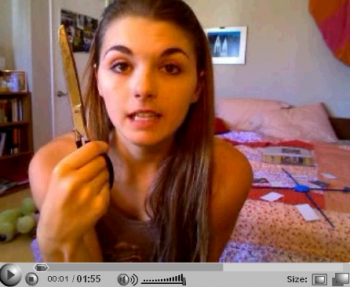lonelygirl15: The Pleasures and Perils of Participation

IN ADDITION TO OUR REGULAR COLUMNISTS AND GUEST COLUMNS, FLOW IS ALSO COMMITTED TO PUBLISHING TIMELY FEATURE COLUMNS, SUCH AS THE ONE BELOW. THE EDITORS OF FLOW REGULARLY ACCEPT SUBMISSIONS FOR THIS SECTION. PLEASE VISIT OUR “CALLS” PAGE FOR CONTACT INFORMATION.
The best television show of the summer of ’06 by far, says Virginia Heffernan, television critic and blogger for The New York Times, was not Rescue Me or Entourage, or even Project Runway. It actually wasn’t on television, strictly speaking, but on YouTube.1 It was lonelygirl15, which is the username of its star, Bree, a personable sixteen year-old video blogger who has appeared in a regular series of short videos, some of which have been viewed more than half a million times. In her vlogs, Bree sits facing a camera in her bedroom and opens up about her life. She talks about her strict, religious parents, her homeschooling, and her friend Daniel (a/k/a Danielbeast), who often appears in the background sprawled on Bree’s bed reading a magazine. Daniel supposedly edits Bree’s videos and occasionally posts some of his own in response to hers; he is probably also madly in love with her. When we first encountered them, lonelygirl15 and Danielbeast seemed like just another couple of kids with a computer and a webcam engaging in participatory culture and creative expression. They could have been any of millions of young people living in the age of web 2.0, when the consumer/producer distinction is passé and one’s whole life is “content.”

But it is now evident that despite appearances, Bree and Daniel are fictional characters rather than real people and that the videos are not their creation alone. It is also clear that those who participated with Bree and Daniel in creating the lg15 phenomenon–by responding to their videos with other videos, by writing about them and spreading their fame, by engaging them in discussion, by taking them at face value, all in good faith–were in some sense bamboozled by a crafty group of storytellers eager to harness the power and exploit the credulity of a new media community and the tastemakers who track it. Like the marks of any good trick, we who were fooled want at once to congratulate and castigate the tricksters. Most of all, we want to understand how they pulled it off. lg15 demonstrates the sharp double edges of today’s participatory media. Web-shared video seems like a democratic technology making it possible for ordinary people in their everyday lives to create an alternative to mainstream media. lonelygirl15 demonstrates that it can also evidently be used by more sophisticated media producers to engage that very audience of eager participants–and to what ends it remains to be seen.
When she first attracted widespread attention, Bree was supposedly an average girl who might just make it in Hollywood on the strength of a homemade screen test. Her videos inspired a legion of admirers and detractors, many of whom posted response videos to YouTube. She got written up not only in numerous entries of Heffernan’s blog, but in the Times of London and in New York magazine, which declared that the videos marked “the birth of a new art form,” a line that the lg15 creators later parroted to advertise their intentions. Just as Bree’s star was rising, however, the lg15 community began to doubt the very authenticity that made her persona compelling. One YouTuber expressed skepticism because the videos use fill lights and have a story arc, two things absent from the typical vlog. Bree would reply to some fellow users’ and some reporters’ e-mails, but remained coy about her identity and location. Wikipedia editors opposed her inclusion in their website with the wacky fervor of JFK conspiracy nuts on the grounds, partly, that no one could say if she was real or fake. An untold multitude began to pay more than casual attention and many found themselves descending, in the terms of their fan community, “down the rabbit hole.” Could lonelygirl15 be a viral marketing campaign for a consumer product yet to be revealed, or an elaborate promotion for another media product, like a horror movie, or more simply a Blair Witch-style mockumentary? Could it all be a kind of game? Is Bree sweet or is she a fraud? Is she sixteen or more like twenty-one? Are the videos spontaneous or scripted? When it came to lg15, the lines between reality and fiction, natural personal expression and the mechanics of narrative, authenticity and contrivance were never very clear, and this is what made it such vital, momentous entertainment.

Although the audience is still watching and wondering about Bree and Daniel, the show lost some of its special charm beginning on September 8, when a confession signed “The Creators” posted on the lonelygirl15.com message board claimed that the videos are the work of filmmakers telling a story rather than kids innocently sharing their lives with the world. The following day, the Los Angeles Times reported that an e-mail supposedly from Bree to a MySpace account had been traced to an IP address at the Creative Artists Agency in Beverly Hills. On September 12, the community was abuzz with news that the woman who appears as Bree in the videos is a 19 year-old actress from New Zealand named Jessica, whose MySpace pictures (concealed by a privacy setting but previously public) were discovered in Google’s cache, apparently by some industrious fans’ sleuthing. For several weeks the YouTube and lg15 fan communities had been skeptical. But with this series of revelations, it seemed that part of what made lg15 so fascinating was gone. lg15 worked the tension between faith and doubt, but without that it began to seem like just another commercial media come-on. As one blogger declared, “lonelygirl15 minutes are up.”
Finally, over the following several days, many media outlets reported identities of “The Creators” as filmmakers Miles Beckett, Ramesh Flinders and Greg Goodfried, and their objective as initiating “a new form of collaborative online entertainment” (Adler). It turns out that the means of their production were quite modest. According to published reports, all they needed were a computer and some software, a $150 camera, some cheap desk lamps, a good actress they found using craigslist, and an open YouTube community where anyone can post or view a video. They shot lonelygirl15 in their own bedrooms.
In the beginning were the videos. Watching them, one can’t help but sympathize with Bree, who complains in her first vlog about her strict upbringing and confesses that the town where she lives is so boring that she has nothing better to do than spend time on her computer. She quotes from Guns, Germs and Steel and idolizes Richard Feynman. Her room is decorated with a Napoleon Dynamite poster and a pink feathered boa. She calls herself a dork and possesses every dorky smart boy’s fantasy, a combination of brains and beauty that makes her seem like a perfect fusion of Alex and Mallory Keaton. Most important, though, Bree has talent as a performer. She uses her eyes, lips, arms, and legs like a comedian of the silent screen. Every time she frowns, shows a wide-opened gaze or protruding tongue, every time she rests her chin on her knee she expresses some essential quality of adolescence. The internet is home to innumerable kids goofing off in front of a camera, pulling faces, dancing in their bedrooms, hamming it up. Bree does this routine as well as anyone.

But that was at most half of lonelygirl15’s appeal. The rest was a product of speculation about the production and provenance of the videos. To those like me who were taken in by lg15, the experience of tracking the theories sometimes overwhelmed the experience of watching the show. Long before The Creators’ confession, there were many hints that lg15 wasn’t just a sincere production of two talented kids. Not only are the videos well lit and not only do they trace an arc, they also have unusually clean sound, good postproduction work with fast motion and music, and lots of editing. Although they are hardly technically polished like a feature film, they are several notches above the typical teenage YouTuber’s work. More curious yet, in a video posted August 6, we see a shrine in Bree’s room to Aleister Crowley, the British occultist. The suggestion that her family’s faith is something obscure, cultish, and possibly Satanic seemed contrived to generate controversy and discussion. Another hint of fakery came when it was discovered that the domain name of a fan site, lonelygirl15.com, was registered one month before the first video was posted, suggesting a planned launch. Finally, for two months no one was able to pin down who exactly Bree is or where she lives. No friends came forward and people’s efforts to get in touch with her produced only a few uninformative e-mails.
Taken together, the primary texts and their surrounding discourses made lg15 into compelling narrative. The videos themselves are full of plot, scenes that play out between Bree and Daniel and stories she tells about her conflict with her homeschooling parents. Blogs, message boards, comment threads, and articles about the videos generated other kinds of narrative: speculative stories that fans and amateur lonelygirl scholars wove about the creation of the vlogs. Considering both the videos and these discourses surrounding them, lg15 was a rich and layered text. One became immersed in its world just as when watching a television serial like Battlestar Galactica or reading a fat novel with a good plot. The videos and the ideas that sprouted from them brought to mind Lost and The Da Vinci Code, and although the audience for lg15 was still smaller than for either of those, its passion was as strong.
Before the confession of fakery, Heffernan told NPR’s On The Media that lg15 fans would not be disappointed to find out that it’s not exactly what it appears to be. Everyone had basically assumed that to be the case. But the fans were dying to know the rest of the story not only of Bree and Daniel and her religious rites and strict parents, but also of how The Creators managed to hook us on it, how they got our attention and what their objectives were. lg15 appealed to what Neal Harris, in his biography of P.T. Barnum, calls “the operational aesthetic.” Barnum’s hoaxes and museum exhibits presented astonishing spectacles and the audience would be eager not only to witness the incredible, but also, essentially, to be shown how the showman pulled it off. The videos were an internet equivalent and the audience was eager to see it unraveled. We were taken in by the magic but at the same time, we needed to know how it had been conjured. The internet has been the site of a zillion hoaxes, but there is something unusual about this one. It comes during this cycle of greater democratization and interactivity, with media users and makers coming together like never before. lg15 has been a contradictory phenomenon, at once drawing its energy from the web community and taking advantage of it. Daniel and Bree’s videos are among the best things to watch on any size screen these days, and this is a testament not only to the craft and imagination of their makers, but also to the audience that has made their feat possible in so many ways.
Note
1 Heffernan made this claim in an interview on NPR’s On The Media during the episode of September 1, 2006.
Image Credits:
3. Reading Viral Marketing for Dummies
Works Cited
Adler, Shawn. “Internet Phenom Lonelygirl15 Reveals Secrets, Says Bree Is Someone ‘Everybody Can Relate To’.” MTV News. MTV Networks. 14 Sept. 2006.
Harris, Neil. Humbug: The Art of P.T. Barnum. Chicago: U of Chicago P, 1981.
Richards, Jonathan. “Worldwide Fame for a Lonely Girl.” Times online. Times Newspapers Ltd. 19 Aug. 2006.
Rushfield, Richard. “Lonelygirl? Not any Longer.” latimes.com. Los Angeles Times. 16 Sept. 2006.
Sternbergh, Adam. “Hey There, Lonelygirl.” New York Magazine. New York Magazine Holdings. 28 Aug. 2006.
Please feel free to comment.
Art or Commerce?
I’m still on the fence about whether or not this is really art, deceptive marketing, or both. On the one hand, I believe that we can learn a great deal about the nature of online identity through such exercises. Its opened my eyes to the potential for deception not only in the arena of online entertainment, but also in the online social networks that have blossomed in the past year. I wonder, would it be immoral to assign students to create their own phony vlogs so as to further this grand experiment?
On the other hand, this might just be the new version of Spam – an ad masquerading as communication (because really vlogs/blogs are as much about communication as they are about entertainment) that seem to clog every truly open channel of communication.
The phenomenon seems to have more in common w/ Alternate Reality Games than traditional texts. In any case, I can only hope that it encourages widespread adoption of so-called “polished” production techniques. Seriously, would it kill vloggers to use a fill light every now and then?
The new medium.
Elliot, I disagree with it being spam. Spam is annoying in that it has no real value and is just an ad. Even if this was made to make money or farther some cause is irrelevant. The point is that all those people enjoyed it and if someone was making money off of it good for them.
Does it even really matter if it was real or not? One thought it was real and enjoyed that feeling and that is what really makes this a great medium. Think, a small company only needs to get a camera, a few good writers and actors and they could make something great. No need for those large Disney/Warner companies.